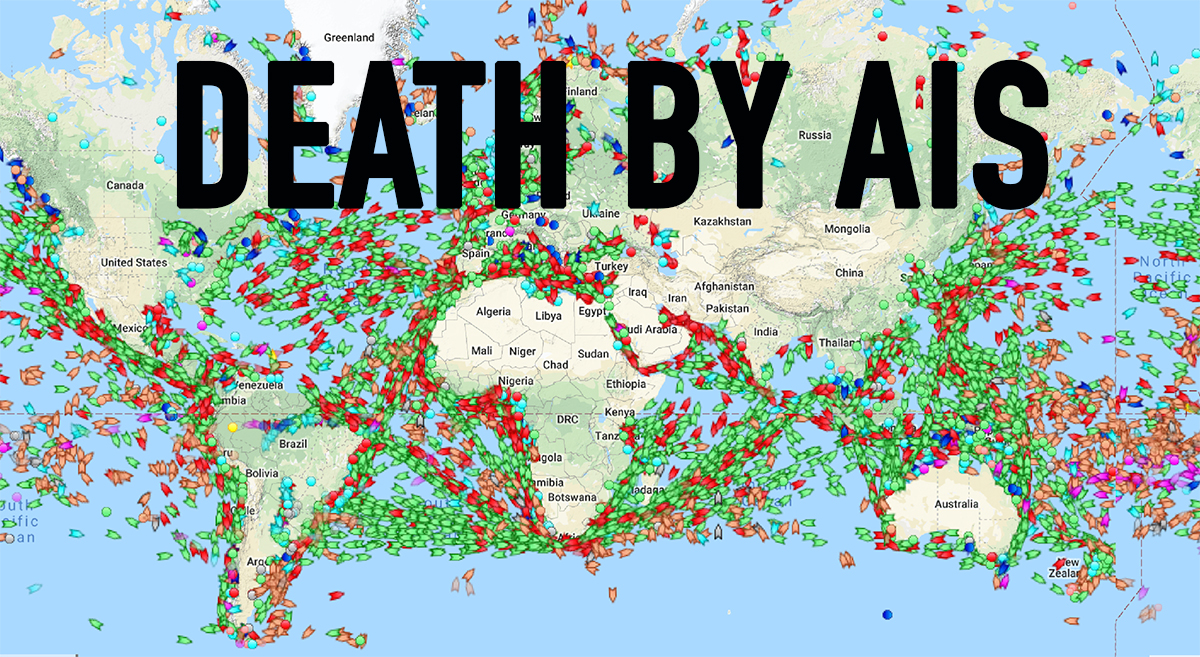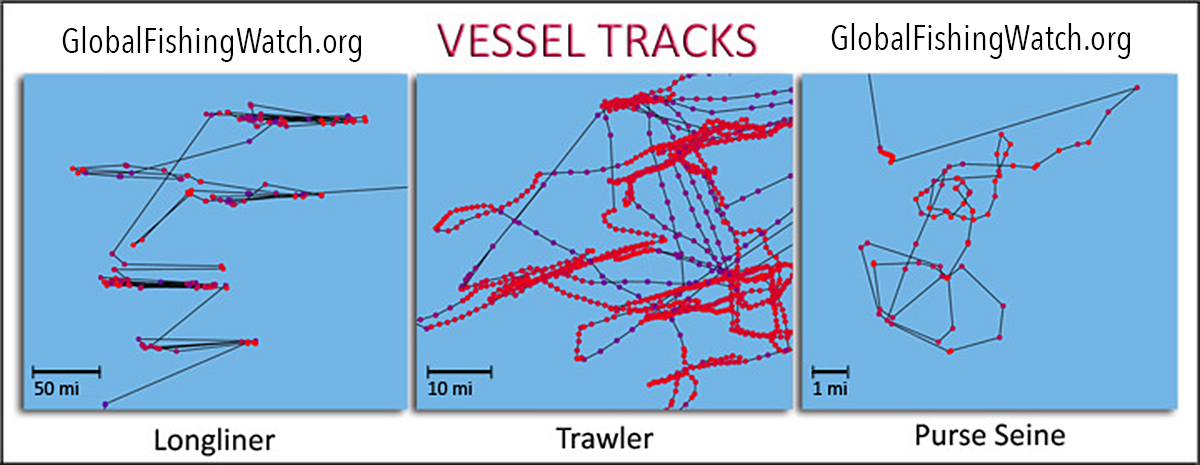

DEATH BY AIS IS A STUPID WAY TO DIE
Look at all those ships.
Each tiny icon represts one of several hundred thousands ships sailing the seven seas. Those ships show up on this graphic because they are running AIS which sends a signal up to satellites revealing their global location.
Probably the single greatest advance in safety at sea in the past twenty years has been the introduction of AIS.
The Automatic Information System not only tells us the identity of ships at sea, it also reveals their size, course, speed, and closest point of approach to our catamaran. It takes all the guess work out of knowing whether a particular ship represents a threat. It also makes collision avoidance easier because when we alter course, the closest point of approach of the ship immedaitely changes, and we instantly know the ship will pass by at a safe distance. In addition, the AIS has alarms on it, and if we are not paying attention, it alerts us to the presence of ships that are a threat.
AIS sends out signals two major ways. One signal goes to a satellite which records the location of the ship at that instant in time. A second line of sight signal goes out on VHF radio frequencies notifying all vessels within a thirty mile radius of its presence.
Sailboats have the second type of AIS. We send out a signal every few seconds informing other vessels in the area that we are there.
The AIS signal lets ships know our size making it easier for them to spot us. They are looking for a thirty-nine foot catamaran and not a container ship when they get our signal. The AIS signal also tells them our speed and course, and it automatically computes the closest point of approach. We also see their AIS signal, and we know their size, course, and closest point of approach. It's a great system when used properly.
Some AIS units give you the option of just receiving the AIS signal without transmitting. There are times when you only want to be in the receive mode because transmitting your location could be hazardous to your life.
With great advances in technology comes great responsibility to use it in a safe and sensible manner.
Sooner or later, some sailors will experience death by AIS.
How can AIS kill you?
It's actually easy.
If you trust your AIS and stop taking watch with your eyes, there is a real possibility that you will die by AIS.
For the AIS system to work, ships must have it installed and turned on.
Not every ship has it installed. Small coastal island traders may not have AIS on board. These small ships ply the same short island hopping routes, and they see no reason to spend the money on it.
Not every ship has it turned on. Some ships don't want the world to know their exact location or what they are doing. If they are up to no good, smuggling drugs or engaged in other nefarious acts, they will not turn on AIS to announce their location or intentions.
Ships engaged in illegal fishing may not turn on their AIS because they don't want the world to know they are breaking international law fishing inside protected areas.
There are times when I don't want to transmit AIS on my boat. When I am sailing in pirate infested waters, turning on my AIS tells pirates exactly where I am, and they know precisely which direction to travel and how many minutes it will take to intercept Exit Only with their present course and speed.
A pirate vessel using AIS can hang back over the horizon and delay their assault until just before sunset or until big ships no longer display on the AIS so nobody can come to my aid.
I would not run my AIS on transmit mode off the coast of Somalia or on the fishing banks of the Nicaragua Rise. Turning on transmit mode will surely put a smile on a pirates face.

Yachties may incorrectly assume that ships always travel in a straight line, and nothing could be further from the truth.
Vessels engaged in fishing hardly ever move in a straight line.
Purse sein fisherman travel in circles trapping schools of fish in their giant net. Long line fisherman zig zag across the the ocean as they set miles of fishing line in the water. Trawlers wander around dragging nets behing them.
If the purse seiners, long liners, and trawlers are fishing illegally, you can be sure their AIS is not on, because they don't want to announce to the world their nefarious deeds.
If you sail at night through an illegal fishing operation, you might collide with a fishing vessel that is keeping a poor watch. I have read many accounts of trawlers engaged in fishing running down other vessels because the watch stander is looking backward at the fishing rig rather than forward toward other vessels.
If you assume fishing vessels have their AIS turned on, and that they have a watch stander looking out for your well-being, you are sadly mistaken.
Hundreds of thousands of vessels with AIS roam the seven seas, and most of them use their AIS. But it only takes one not using their AIS or not paying attention to their AIS to run you down.
I was talking to the captain of a large vessel who told me that even with AIS, the bridge of a ship may not be able to spot a small yacht in front of them. The AIS tells them a small yacht is near, but they are unable to spot the yacht with their eyes at night in the dark. The captain said he came very close to running down a sailboat on a dark night because the sailboat was not displaying running lights.
AIS is only as good as the GPS location it sends out, and if your GPS is off by a few hundred feet, your AIS information will be wrong by the same amount.
When you install AIS on your boat, you fill out an application that shows the location of the AIS transmitter. Not a big deal when your boat is only 39 feet long. But when you are a massive eight-hundred foot long freighter, the location of the AIS transmitter becomes supremely important when computing the closest point of approach. If it says they will pass within a few hundred feet, you better hope they filled out the AIS application correctly - because the closest point of approach is computed based on the location of the transmitter. If they move the transmitter from the front to the back of the ship, the AIS position could be off by eight-hundred feet, and computations of closest point of approach would be seriously wrong.
The abuse of AIS will eventually result in the death of sailors.
I heard of one cruisng family who turns on the AIS at night, and everyone goes to sleep. No one stands watch. The AIS alarm is supposed to wake them up if a ship comes over the horizon. But if no one hears the alarm or sleeps through the alarm, they could be in mortal danger. If the AIS malfunctions or loses power, they could be in mortal danger. If a ship comes over the horizon not running AIS, they could be in mortal danger. If a vessel is engaged in illegal fishing, they could be in mortal danger.
When I sailed from Galapagos to the Marquesas, I passed within a mile of five stationary fish processing ships lined up in a row. If I had not been standing watch, I could have hit any of the five massive fish factories more than a thousand miles from land. They would not have run into me. I would have run into them because I did not know they were there.
If you are a fish factory running an illegal operation, you probably don't run your AIS. It's not just the fish factory ships that are the risk. It takes dozens of fishing vessels supplying those fish processing ships to make the operation viable. So you are dodging a fishing fleet in the dark in addition to the factory ships.
When I lived in Saudi Arabia, I heard a story about tying up your camel. A bedouin came to Mohammed and dropped the rope from the camel bridle to the ground saying, "God will take care of my camel." Mohammed responded, "First tie up your camel, and then trust God to take care of it."
That's the way it is with AIS.
Don't think that AIS will take care of you. Instead have someone actually standing watch 24 hours a day when you sail offshore, and then trust your AIS to take care of you.
It takes about ten minutes for a fast ship to come over the horizon and run you down. You need to have someone look around the horizon at least every ten to fifteen minutes.
Singlehanders are between a rock and a hard place. They have to get their sleep sometime. AIS will give them a better margin of safety, but if they want to live long and prosper, they need to set a timer and take a look around the horizon every fifteen minutes.
Death by AIS is a stupid way to die. Don't let it happen to you.
Awesome music video that captures the essence of what it's like to sail offshore in a catamaran around the world when conditions are less than perfect. David Abbott from Too Many Drummers sings the vocals, and he also edited the footage from our Red Sea adventures. This is the theme song from the Red Sea Chronicles.
Sailing up the Red Sea is not for the faint of heart. From the Bab al Mandeb to the Suez Canal, adventures and adversity are in abundance. If you take things too seriously, you just might get the Red Sea Blues.
If you like drum beats, and you like adventure, then have a listen to the Red Sea Chronicles Trailer.
Flying fish assault Exit Only in the middle of the night as we sail through the Arabian Gulf from the Maldives to Oman. And so begins our Red Sea adventures.
Sailing through Pirate Alley between Yemen and Somalia involves calculated risk. It may not be Russian Roulette, but it is a bit of a worry. Follow Team Maxing Out as they navigate through Pirate Alley.
Stopping in Yemen was just what the doctor ordered. We refueled, repaired our alternator, and we made friends with our gracious Yemeni hosts. We also went to Baskins Robbins as a reward for surviving Pirate Alley.
After you survive Pirate Alley, you must sail through the Gate of Sorrows (Bab Al Mandab) at the southern entrance to the Red Sea. The Gate of Sorrows lived up to its name with fifty knots of wind and a sandstorm that pummeled Exit Only for two days. Life is good.
Although I like the feel of a paper book in my hand, I love trees even more. When people purchase an eBook, they actually save trees and save money as well. Ebooks are less expensive and have no negative impact on the environment. All of Dr. Dave's books are available at Save A Tree Bookstore. Visit the bookstore today and start putting good things into your mind. It's easy to fill your mind with positive things using eBooks. No matter where you are or what you are doing, you can pull out your smart phone or tablet and start reading. You can even use electronic highlighters and make annotations in your eBooks just like paper books.